Transportation Accessibility Evaluation of Educational Institutions Conducting Field Environmental Education Activities in Ecological Protection Areas: A Case Study of Zhuhai City
Abstract
:1. Introduction
2. Materials and Methods
2.1. Overview of the Study Area
2.2. Data Source
2.3. Research Methods
2.3.1. Kernel Density Estimation
2.3.2. Two-Step Floating Catchment Area Method
2.3.3. Thiessen Polygons
3. Results
3.1. Spatial Layout of Teaching Institutions and Students with Ecological Protection Zones
3.2. Accessibility of Educational Institutions to Ecological Protection Zones
3.3. Division of Service Scope for Environmental Education in Ecological Protection Zones
4. Discussion
4.1. Study Innovations and Significance
4.2. Countermeasures and Suggestions
- Educational institutions in Zhuhai are mainly located in the subdistricts of Cuixiang and Qianshan. Field environmental education resources are insufficient and have low accessibility to ecological protection zones in these areas. Therefore, the coastal ecological area resources in central and southern Xiangzhou District should be fully utilized. Moreover, the coastal ecological protection zones and the environmental protection demonstration bases in Xiangzhou District should be strengthened. This will provide a certain environmental education practice base for education institutions in Xiangzhou District while alleviating the burden of conducting field environmental education placed on Mangzhou Wetland Park. Simultaneously, such efforts will improve spatial accessibility between educational institutions in Xiangzhou District and field environmental education bases. However, strict limits should also be placed on natural resources development, planting, breeding, and other activities detrimental to the construction of ecological services in the ecological protection zones. In sum, this will aid in the proper management of field environmental education activities while leaving ecological functions undisturbed.
- While the central and southern areas in Zhuhai City have many students, the ecological protection zones in these areas are limited. Thus, increasing the scales of ecological protection zones in central and southern Zhuhai City and developing marine parks with marine environmental protection in southern Zhuhai City is necessary. The marine park will primarily be used to protect, repair, and properly use living resources through publicity and educational infrastructure construction. These efforts will improve the efficiency of field environmental education activities in central and southern Zhuhai City.
4.3. Outlook
4.4. Mechanism behind the Spatial Differences
- The effect of regional economic development on educational institutions: Differences in economic development are the primary factor of the imbalanced spatial distribution of educational institutions within the city. Due to factors such as geographic location and industry structure, the economic development of districts in Zhuhai City varied significantly, leading to an imbalance in the investment of education and construction funding for educational institutions. Most educational institutions were highly concentrated in regions with rapid economic development, such as Xiangzhou District.
- The demand for educational resources by population size: Population size was the core element affecting the spatial distribution of educational institutions, as large populations provide a stable source of students. Therefore, the concentration of educational institutions in a given region was positively correlated to its population size.
5. Conclusions
- Educational institutions in Zhuhai are mainly located in the subdistricts of Xiangzhou District, with a “one primary and two secondary” spatial structure. Here, “one primary” refers to Cuixiang Subdistrict and Qianshan Subdistrict, while “two secondary” refers to Gongbei Subdistrict and Baijiao Town. Students in Zhuhai are mainly distributed in villages and towns in northeastern Xiangzhou District, with a “one core and two centers” structural characteristic. “One core” is Tangjiawan Town, while “two centers” are Hongqi Town and Sanzao Town. The relatively large nature reserves are mainly distributed in Tangjiawan Town in northeastern Zhuhai, Jingan Town in central Zhuhai, and the adjacent area of the Baiteng Subdistrict. The ecological protection zones with relatively small areas are mainly distributed in southern and northwestern Zhuhai City. With this, we concluded that environmental education resources in both high-value and second-high-value areas of educational institution density are relatively scarce. In contrast, environmental education resources in the high-value and second-high-value areas of student density are relatively affluent.
- Educational institutions with different levels and specialties had similar levels of spatial accessibility to ecological protection zones. Educational institutions with high and relatively high accessibility are mainly distributed in the township subdistricts in northeastern Xiangzhou District and central Doumen District. Educational institutions with general and relatively low accessibility are mainly located in township subdistricts in the central and southern sections of Zhuhai City. Finally, educational institutions with the poorest accessibility are mainly located in township subdistricts in the central part of the Xiangzhou District. Kindergartens and primary schools in Zhuhai City have the highest accessibility to environmental education bases in ecological protection zones; here, the spatial representation is the most similar to the overall accessibility of educational institutions. Junior high schools (secondary technical schools) and mixed high schools have the second highest accessibility to environmental education bases in ecological protection zones, while senior high schools (vocational high schools) and higher education institutions high schools have relatively low accessibility to environmental education bases in ecological protection zones. Meanwhile, special skills schools have the poorest level of accessibility to environmental education bases in ecological protection zones.
- Zhuhai City can be divided into 15 field environmental education blocks. Block 1, block 3, and block 4 mainly provide field environmental education services to Xiangzhou District, while block 5 mainly provides services to Hengqin New District. Next, block 6, block 9, block 10, block 11, and block 12 mainly provide services to Doumen District, while block 13 and block 15 mainly provide services to Gaolan Port. Finally, block 7, block 8, and block 14 mainly provide services to Jinwan District, while block 2 does not provide any such services. There are relatively strong spatial dispersions among educational institutions located in Xiangzhou District, the western section of Jinwan District, and the western, central, and eastern sections of Doumen District with the ecological protection zones within their respective blocks. By contrast, relatively weak dispersions are found among educational institutions located in the central and eastern parts of Jinwan District and northern and southern parts of Doumen District, with the ecological protection zones within their respective blocks. Hence, we concluded that strong spatial dispersions exist among high-end educational institutions and relatively weak dispersion among second-high value areas.
Author Contributions
Funding
Institutional Review Board Statement
Informed Consent Statement
Data Availability Statement
Conflicts of Interest
References
- Heras, R. Contribution of environmental education centres to fieldtrips in primary schools (Original title in Catalan: Contribució delsequipaments d’educació ambiental a les sortides escolars del’educació primària). Environ. Educ. Res. 2015, 22, 438–439. [Google Scholar] [CrossRef]
- Ordon, K.J.; Bartelheimer, M.; Asshoff, R. Biology student teachers’ interest and self-efficacy in planning and conducting field trips after participation in a university course. Environ. Educ. Res. 2021, 27, 88–109. [Google Scholar] [CrossRef]
- Tian, S.Z.; Li, X.M.; Yang, J.; Zhang, C.H.; Zhang, Y. Initial Study on Triaxiality of Human Settlements—In the Case of 10 Districts (Counties) of Dalian. Sustainability 2014, 6, 7276–7291. [Google Scholar] [CrossRef] [Green Version]
- Rickinson, M. Learners and Learning in Environmental Education: A critical review of the evidence. Environ. Educ. Res. 2001, 7, 207–320. [Google Scholar] [CrossRef]
- Detra, D.E.; James, L.P. Evaluating the Effectiveness of Residential Environmental Education Programs in Fostering Postive Attitudes toward Wildlife. J. Environ. Educ. 1999, 31, 33–39. [Google Scholar] [CrossRef]
- Garret, S.R.T.; Granek, E.; Lengel, K.L.; Raboude, M.J.; Reason, P.F.; Sewall, B.J. Environmental education as a component of multidisciplinary conservation programs: Lessons from the conservation initiatives for critically endangered fruit bats in the Western Indian Ocean. Conserv. Programs 2005, 19, 75–85. [Google Scholar] [CrossRef]
- Jan, V.D.P.; Myrna, C.C.; Merlijn, V.W.; Wouter, T.D.G. Assessing the effectiveness of environmental education: Mobilizing public support for Philippine crocodile conservation. Conserv. Lett. 2011, 4, 313–323. [Google Scholar] [CrossRef]
- Kara, C.; Matthew, B. Environmental education: Time to reflect, time for change. Eval. Program Plan. 2010, 33, 155–158. [Google Scholar]
- Joe, E.H. Environmental education evaluation: Reinterpreting education as a strategy for meeting mission. Eval. Program Plan. 2010, 33, 180–185. [Google Scholar] [CrossRef]
- Lucie, S. Environmental Education and Sustainable Development: A Further Appraisal. Can. J. Environ. Educ. 1996, 1, 7–34. [Google Scholar]
- Ágnes, Z.; Zsuzsanna, M.S.; Anna, S.; Tamás, K. Greening due to environmental education? Environmental knowledge, attitudes, consumer behavior and everyday pro-environmental activities of Hungarian high school and university students. J. Clean. Prod. 2013, 48, 126–138. [Google Scholar] [CrossRef]
- Kuhar, C.W.; Bettinger, T.L.; Lehnhardt, K.; Osuo, T.; Cox, D. Evaluating for Long-Term Impact of an Environmental Education Program at the Kalinzu Forest Reserve, Uganda. Am. J. Primatol. 2010, 72, 407–413. [Google Scholar] [CrossRef] [PubMed]
- Fu, H.L.; Liu, X.J. A Study on the Impact of Environmental Education on Individuals’ Behaviors Concerning Recycled Water Reuse. Eurasia J. Math. Sci. Technol. Educ. 2017, 13, 6715–6724. [Google Scholar] [CrossRef]
- Damerell, P.; Howe, C.; Milner-Gulland, E.J. Child-orientated environmental education influences adult knowledge and household behaviour. Environ. Res. Lett. 2013, 8, 015016. [Google Scholar] [CrossRef]
- Ballantyne, R.; Fien, J.; Packer, J. School Environmental Education Programme Impacts upon Student and Family Learning: A Case Study Analysis. Environ. Educ. Res. 2001, 7, 23–27. [Google Scholar] [CrossRef] [Green Version]
- Robert, L.R. The influence of landscape preference and environmental education on public attitudes toward wildfire management in the Northeast pine barrens (USA). Landsc. Urban Plan. 2012, 107, 55–68. [Google Scholar] [CrossRef]
- Arjen, E.J.; Wals, M.B.; Justin, D.; Robert, B.S. Convergence between Science and Environmental Education. Science 2014, 344, 583–584. [Google Scholar] [CrossRef]
- Shirley, V.; Will, F. Interdisciplinary environmental education: Elements of field identity and curriculum design. J. Environ. Stud. Sci. 2011, 1, 14–35. [Google Scholar] [CrossRef]
- Chang, C.H.; Gillian, K. Considering geographical and environmental education at scales. Intern. Res. Geogr. Environ. Educ. 2021, 30, 91–94. [Google Scholar] [CrossRef]
- Sufia, R.; Arisona, R.D. Introducing environmental education to early children through 3R activities (an effort for Indonesia free trash). IOP Conf. Ser. Earth Environ. Sci. 2021, 747, 012030. [Google Scholar] [CrossRef]
- Chang, C.S.; Chen, T.S.; Hsu, W.H. The study on integrating Web Quest with mobile learning for environmental education. Comput. Educ. 2011, 57, 1228–1239. [Google Scholar] [CrossRef]
- Vicente, A.C.B.; Rafael, M.D.; Víctor, A.C.B.; Ana, D.C.T.S. Environmental education for small- and medium-sized enterprises: Methodology and e-learning experience in the Valencian region. J. Environ. Manag. 2008, 87, 507–520. [Google Scholar] [CrossRef]
- Barbalios, N.; Ioannidou, I.P.; Tzionas, S.P. A model supported interactive virtual environment for natural resource sharing in environmental education. Comput. Educ. 2013, 62, 231–248. [Google Scholar] [CrossRef]
- Nicole, B. Environmental education in Costa Rica: Building a framework for sustainable development? Int. J. Educ. Dev. 2008, 28, 348–358. [Google Scholar] [CrossRef] [Green Version]
- Keith, G.T.; Marianne, E.K. Urban Environmental Education from a Social-Ecological Perspective: Conceptual Framework for Civic Ecology Education. Cities Environ. 2010, 3, 11. [Google Scholar] [CrossRef]
- John, H. Locating Environmental Education between Modern Capitalism and Postmodern Socialism: A Reply to Lucie Sauvé. Can. J. Environ. Educ. 1999, 4, 36–45. [Google Scholar]
- Elizabeth, A.C.R. Building Teacher Identity in Environmental and Sustainability Education: The Perspectives of Preservice Secondary School Geography Teachers. Sustainability 2021, 13, 5321. [Google Scholar] [CrossRef]
- Niranjan, C. What Makes Environmental and Sustainability Education Transformative: A Re-Appraisal of the Conceptual Parameters. Sustainability 2021, 13, 5100. [Google Scholar] [CrossRef]
- Annelise, C.H.; William, J.H. Challenges and opportunities for evaluating environmental education programs. Eval. Program Plan. 2010, 33, 159–164. [Google Scholar]
- Alex, K.; Marianne, E.K.; Richard, C.S. The impact of environmental education on sense of place among urban youth. Ecosphere 2012, 3, 29. [Google Scholar] [CrossRef]
- Zhang, D.H.; Zhou, C.S.; Xu, W.W. Spatial-Temporal Characteristics of Primary and Secondary Educational Resources for Relocated Children of Migrant Workers: The Case of Liaoning Province. Complexity 2020, 13, 7457109. [Google Scholar] [CrossRef]
- He, X.; Yuan, X.D.; Zhang, D.H.; Zhang, R.R.; Li, M.; Zhou, C.S. Delineation of Urban Agglomeration Boundary based on Multisource Big Data Fusion—A Case Study of Guangdong–Hong Kong–Macao Greater Bay Area (GBA). Remote Sens. 2021, 13, 1801. [Google Scholar] [CrossRef]
- Bjarne, B.J.; Karsten, S. The Action Competence Approach in Environmental Education. Environ. Educ. Res. 1997, 3, 163–178. [Google Scholar]
- Amy, M.K.; Shari, M.; Tina, G.; Allison, B.; Diana, M.; Shane, M.T.C. EcoMOBILE: Integrating augmented reality and probeware with environmental education field trips. Comput. Educ. 2013, 68, 545–556. [Google Scholar]
- Cynthia, M.F.; Stephan, M.F. The importance of connection to nature in assessing environmental education programs. Stud. Educ. Eval. 2014, 41, 85–89. [Google Scholar] [CrossRef]
- Regula, K.G.; Kurt, H.; Balz, W. Studies on a socio-ecological approach to environmental education: A contribution to a critical position in the education for sustainable development discourse. Environ. Educ. Res. 2006, 12, 101–114. [Google Scholar] [CrossRef] [Green Version]
- Li, C.X.; Gao, X.; He, B.J.; Wu, J.Y.; Wu, J.Y.; Wu, K.N. Coupling Coordination Relationships between Urban-industrial Land Use Efficiency and Accessibility of Highway Networks: Evidence from Beijing–Tianjing–Hebei Urban Agglomeration, China. Sustainability 2019, 11, 1446. [Google Scholar] [CrossRef] [Green Version]
- Lu, C.P.; Xue, B.; Lu, C.Y.; Wang, T.; Jiang, L.; Zhang, Z.L.; Ren, W.X. Sustainability Investigation of Resource-Based Cities in Northeastern China. Sustainability 2016, 8, 1058. [Google Scholar] [CrossRef] [Green Version]
- Yang, J.; Guo, A.D.; Li, X.M.; Huang, T. Study of the Impact of a High-Speed Railway Opening on China’s Accessibility Pattern and Spatial Equality. Sustainability 2018, 10, 2943. [Google Scholar] [CrossRef] [Green Version]
- Yang, J.; Yang, R.M.; Sun, J.; Huang, T.; Ge, Q.S. The Spatial Differentiation of the Suitability of Ice-Snow Tourist Destinations Based on a Comprehensive Evaluation Model in China. Sustainability 2017, 9, 774. [Google Scholar] [CrossRef] [Green Version]
- Radke, J.; Mu, L. Spatial decomposition, modeling and mapping service regions to predict access to social programs. Geogr. Inf. Sci. 2000, 6, 105–112. [Google Scholar] [CrossRef]
- Luo, W.; Wang, F.H. Measure of spatial accessibility to healthcare in a GIS environment: Synthesis and a case study in Chicago. Environ. Plan. B Plan. Des. 2003, 30, 865–884. [Google Scholar] [CrossRef] [PubMed] [Green Version]
- Cheung, P.; Zhang, L. Environment for Preschool Children to Learn Fundamental Motor Skills: The Role of Teaching Venue and Class Size. Sustainability 2020, 12, 9774. [Google Scholar] [CrossRef]
- Tsebo, K.M. Action research and environmental education within a home-based setup to conscientise children towards littering. Environ. Dev. Sustain. 2021. [Google Scholar] [CrossRef]
- Claudio, Q.R.; Catherine, O.; Jessica, D.O.; Bárbara, S.R. Impact of 2020 COVID-19 lockdown on environmental education and leatherback sea turtle (Dermochelys coriacea) nesting monitoring in Pacuare Reserve, Costa Rica. Biol. Conserv. 2021, 255, 108981. [Google Scholar] [CrossRef]
- Parita, S.; George, A. Environmental education and awareness: The present and future key to the sustainable management of Ramsar convention sites in Kenya. Int. Environ. Agreem. Politics Law Econ. 2021. [Google Scholar] [CrossRef]
- Wang, R.; Jia, T.T.; Qi, R.; Cheng, J.H.; Zhang, K.; Wang, E.W.; Wang, X. Differentiated Impact of Politics-and Science-Oriented Education on Pro-Environmental Behavior: A Case Study of Chinese University Students. Sustainability 2021, 13, 616. [Google Scholar] [CrossRef]
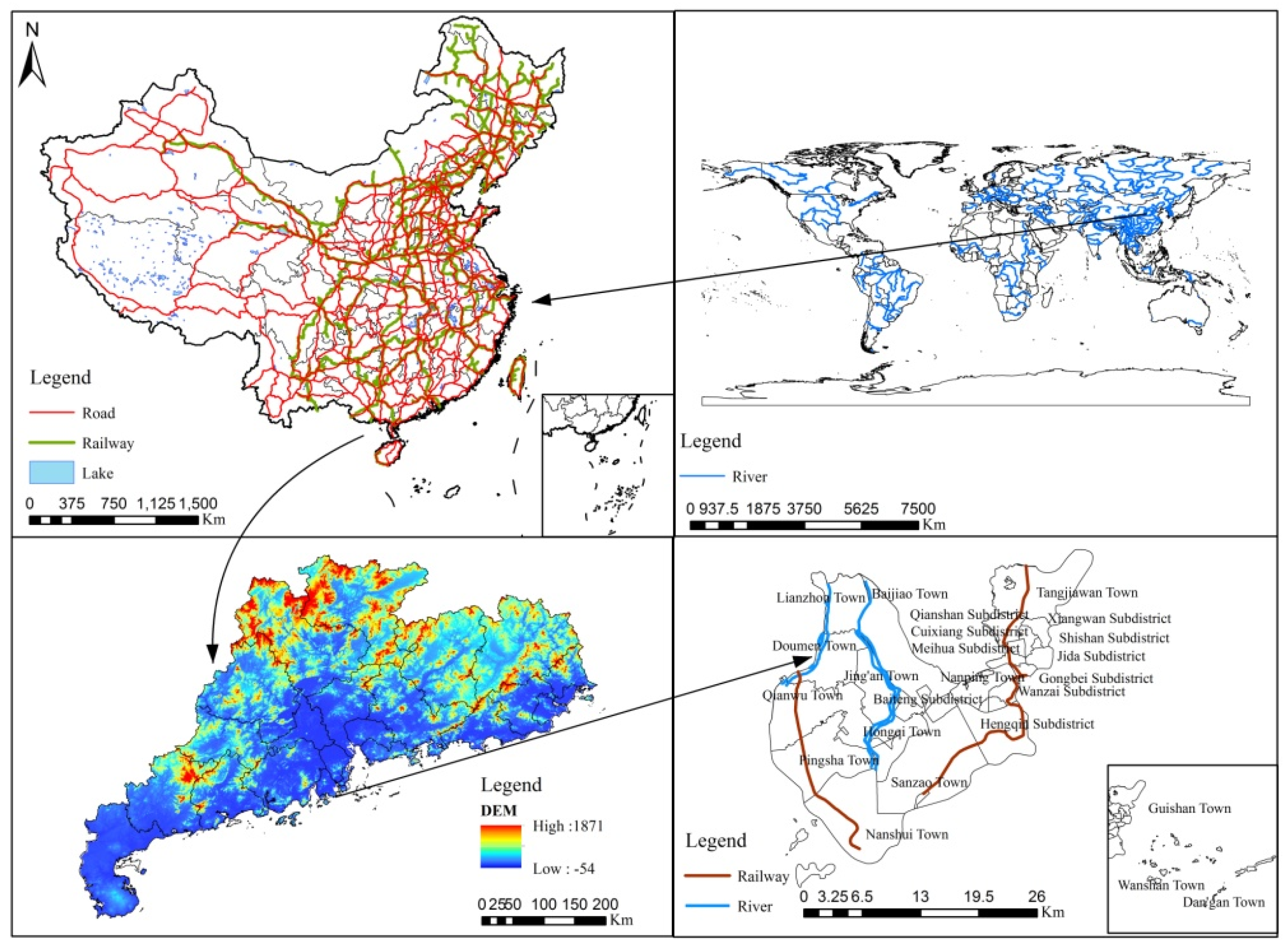
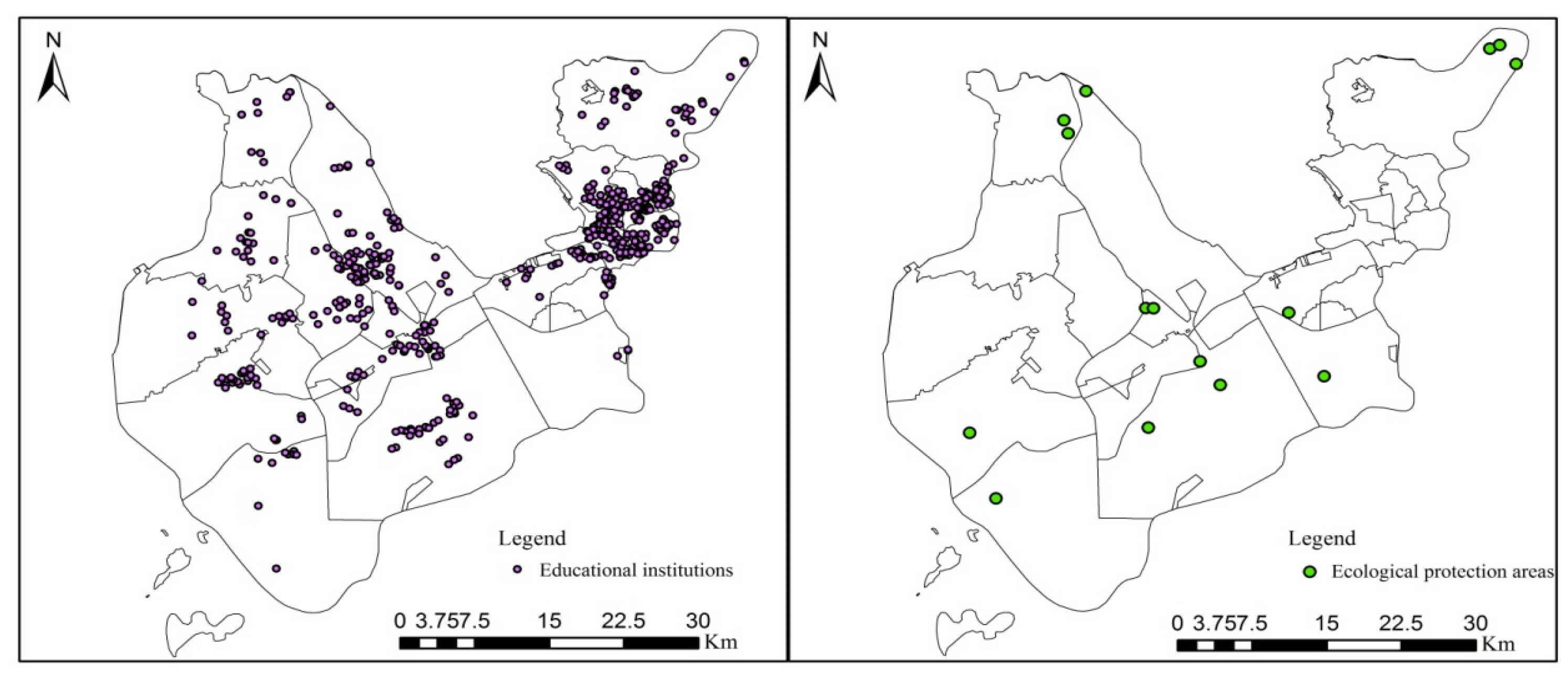
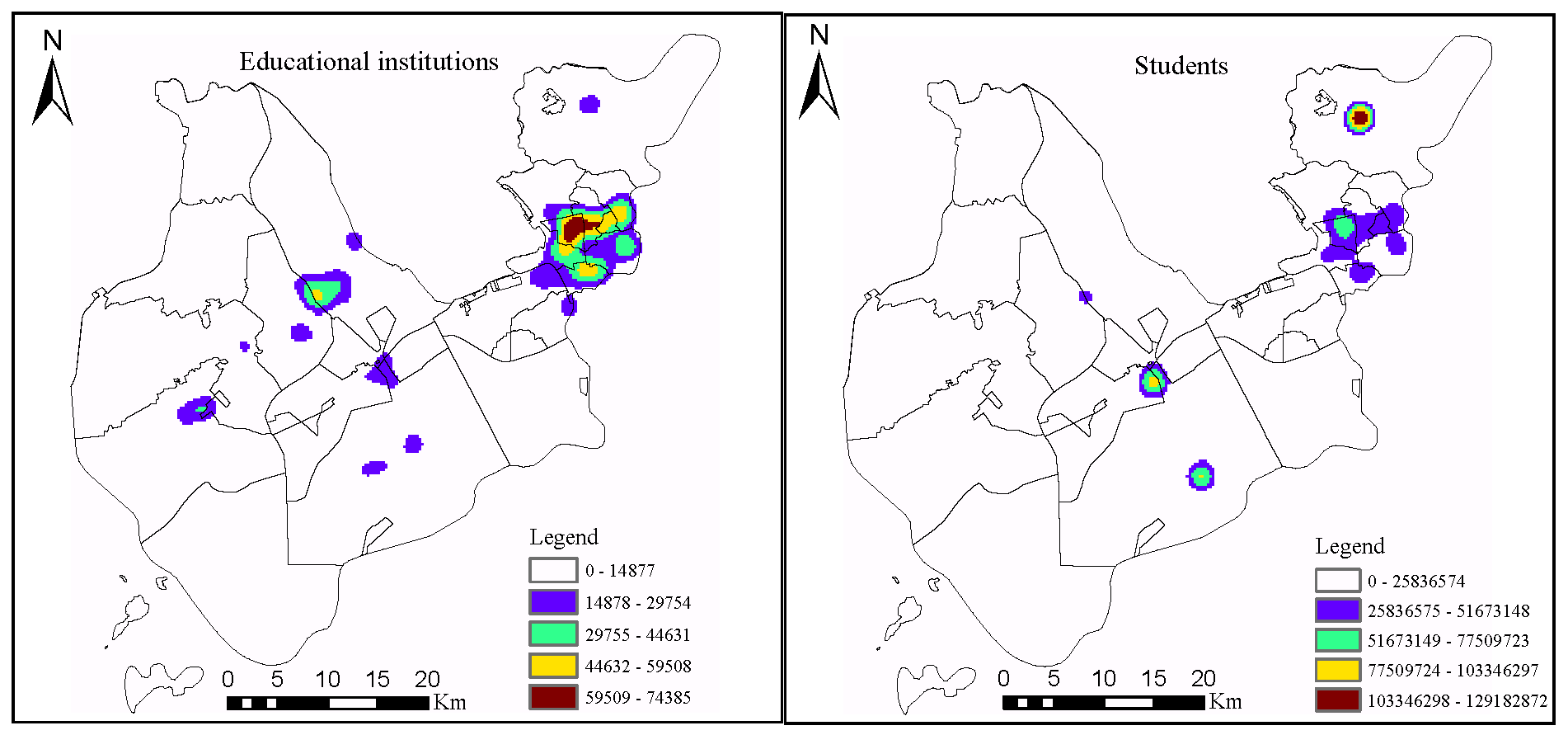
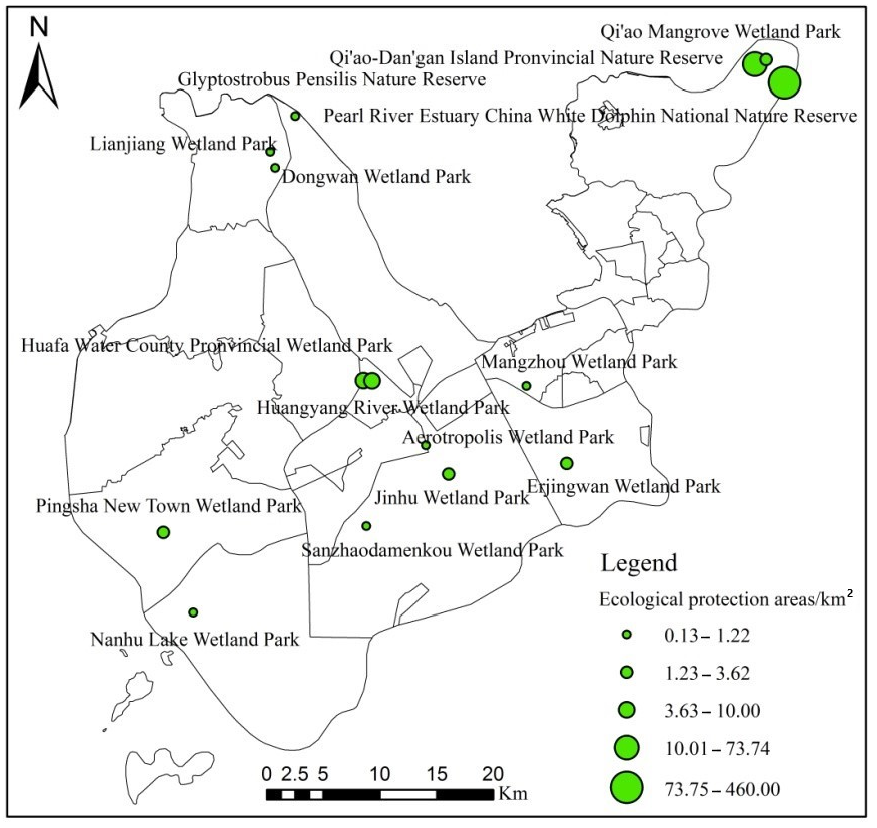
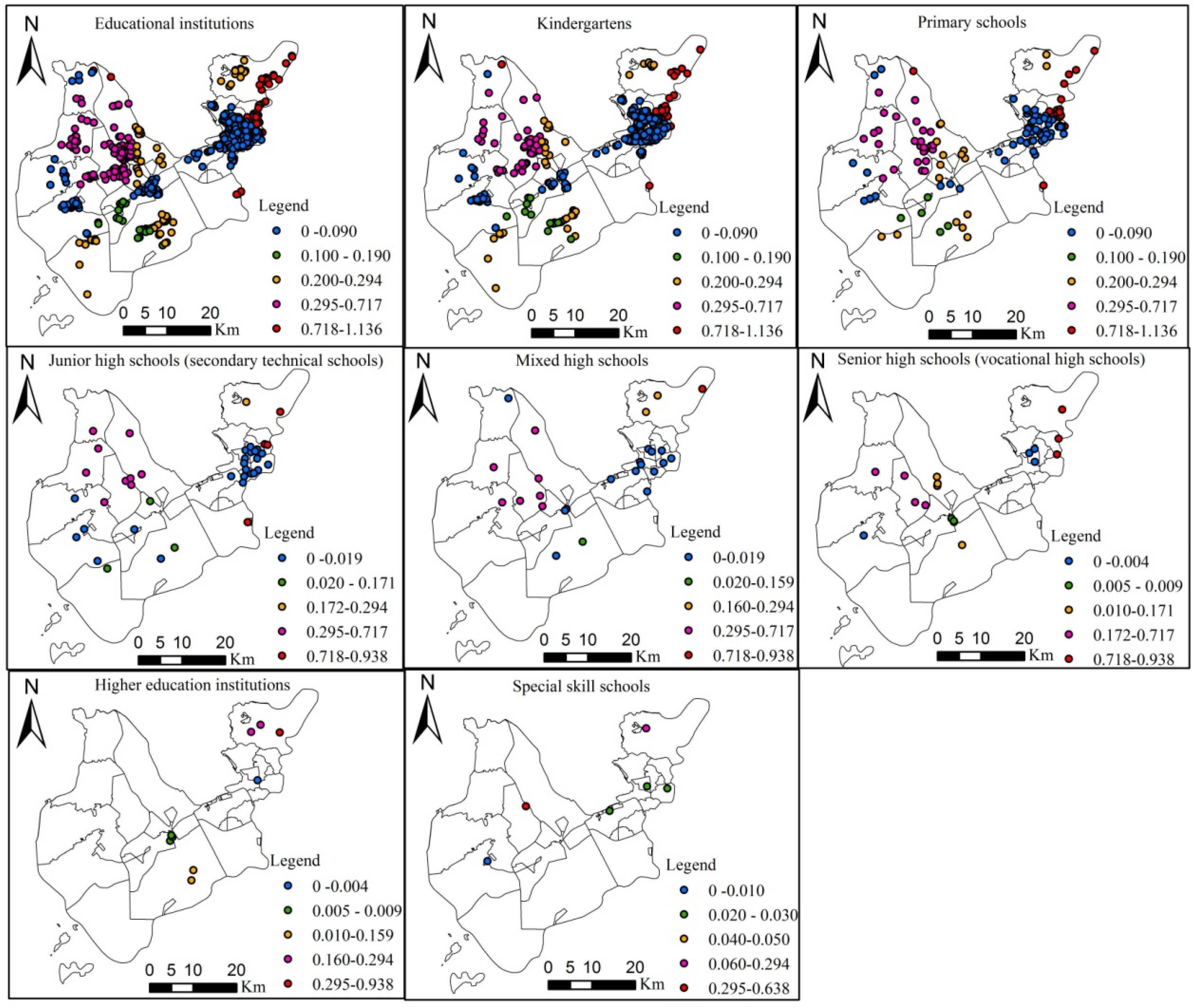
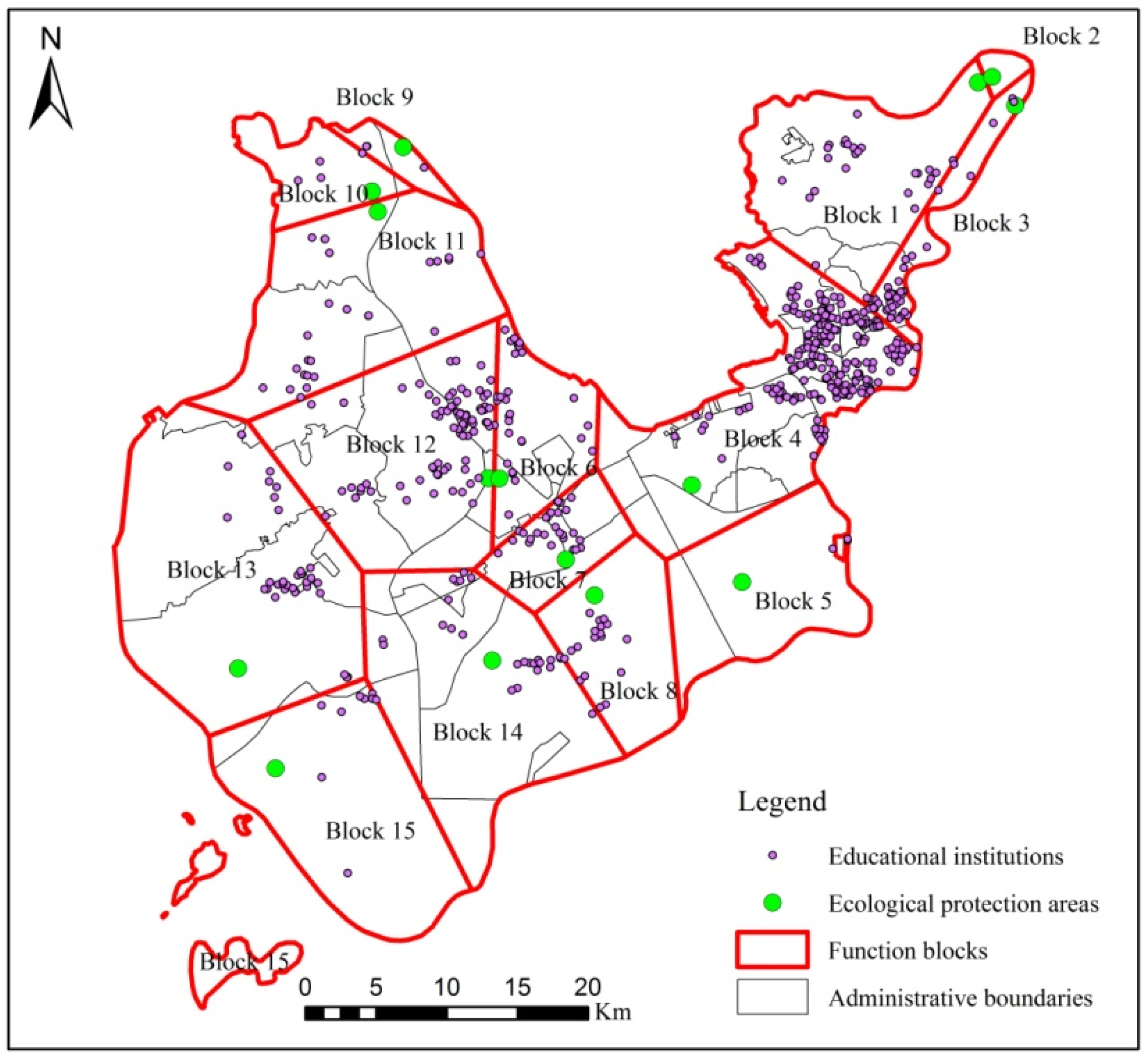
| Data Category | Data Description | Data Type | Data Source |
|---|---|---|---|
| School data | Number of students, educational level, floor area, etc. | Panel data | Educational facilities statistics |
| Ecological protection zone data | Ecological protection zone name and area | Panel data | Statistical report on ecological protection zones |
| Traffic network data | Highways and railways | Vector data | Baidu map |
| Spatial coordinate data | Latitude and longitude coordinates of schools and ecological protection zones | Vector data | Baidu map coordinate pickup system |
| Administrative division data | Administrative boundary | Vector data | Resources and Environment Science and Data Center of the Chinese Academy of Sciences |
| DEM elevation data | Topographic elevation | Raster data | Resources and Environment Science and Data Center of the Chinese Academy of Sciences |
| Code of Block | Name of Block |
|---|---|
| Block 1 | Qi’ao-Dangan Island Provincial Nature Reserve |
| Block 2 | Qi’ao Mangrove Wetland Park |
| Block 3 | Pearl River Estuary China White Dolphin National Nature Reserve |
| Block 4 | Mangzhou Wetland Park |
| Block 5 | Erjingwan Wetland Park |
| Block 6 | Huangyang River Wetland Park |
| Block 7 | Aerotropolis Wetland Park |
| Block 8 | Jinhu Wetland Park |
| Block 9 | Glyptostrobus Pensilis Nature Reserve |
| Block 10 | Lianjiang Wetland Park |
| Block 11 | Dongwan Wetland Park |
| Block 12 | Huafa Water County Provincial Wetland Park |
| Block 13 | Pingsha New Town Wetland Park |
| Block 14 | Sanzhaodamenkou Wetland Park |
| Block 15 | Nanhu Lake Wetland Park |
Publisher’s Note: MDPI stays neutral with regard to jurisdictional claims in published maps and institutional affiliations. |
© 2021 by the authors. Licensee MDPI, Basel, Switzerland. This article is an open access article distributed under the terms and conditions of the Creative Commons Attribution (CC BY) license (https://creativecommons.org/licenses/by/4.0/).
Share and Cite
Zhou, C.; Zhang, D.; He, X. Transportation Accessibility Evaluation of Educational Institutions Conducting Field Environmental Education Activities in Ecological Protection Areas: A Case Study of Zhuhai City. Sustainability 2021, 13, 9392. https://doi.org/10.3390/su13169392
Zhou C, Zhang D, He X. Transportation Accessibility Evaluation of Educational Institutions Conducting Field Environmental Education Activities in Ecological Protection Areas: A Case Study of Zhuhai City. Sustainability. 2021; 13(16):9392. https://doi.org/10.3390/su13169392
Chicago/Turabian StyleZhou, Chunshan, Dahao Zhang, and Xiong He. 2021. "Transportation Accessibility Evaluation of Educational Institutions Conducting Field Environmental Education Activities in Ecological Protection Areas: A Case Study of Zhuhai City" Sustainability 13, no. 16: 9392. https://doi.org/10.3390/su13169392
APA StyleZhou, C., Zhang, D., & He, X. (2021). Transportation Accessibility Evaluation of Educational Institutions Conducting Field Environmental Education Activities in Ecological Protection Areas: A Case Study of Zhuhai City. Sustainability, 13(16), 9392. https://doi.org/10.3390/su13169392







